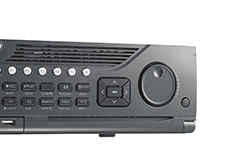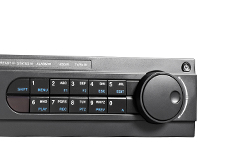Network Video Recorders
Value Series Plug and Play NVR’s
Our popular Plug and Play NVRs provide easy installation and operation. These Value NVRs manage bandwidth and storage with the latest H.265+ compression technology. High-performance cameras are also supported recording of up to 12 MP camera resolution, Ultra High Definition (UHD) output up to 4K. With from 4 to 32 channel input and 4 to 16 built-in PoE ports, these NVR’s easily installs and automatically adds connected IP cameras on start-up. Included are Audio and Alarm inputs and outputs and support for eSATA HDD’s and DVD-RW recorders. With up to 32 TB of HDD space, storage space is never an issue.
Smart Pro NVR’s
Meeting all bandwidth and storage utilization requirements, the Smart Pro NVRs support recording of up to 12 MP camera resolution, Ultra High Definition (UHD) output up to 4K, up to 192 TB of storage capacity and H.265+ compression to increase storage space by 50-70 percent. With capacity of from 16 to 156 inputs, these recorders offer up to 24 SATA interfaces and one eSATA interface for recording and backup. The NVR features Hikvision’s unique optimized H.265+ compression which means that bitrate and bandwidth requirements are reduced and storage space is increased by up to 50-70%. These NVR’s provide user-friendly centralized management, including configuration, import and export of information, real-time information display, and two-way audio. To make surveillance even more efficient, the NVR supports Hikvision’s Smart Suite of analytics, video content analysis such as alarms for intrusion detection, and has a Smart search, Smart playback with Event Playback and Event Back Up function for a specified field of view. Playback is a breeze with the smart playback function. It supports 16 camera synchronous playback, instant playback and reverse playback to insure you won’t miss a thing.
DeepinMind NVRs
DeepinMind NVRs include a high speed GPU that processes video data at tremendous speeds to isolate detection of human subjects, significantly improving video analytics accuracy and reliability. Inaccurate alarms from non-human subjects such as animals, vehicles, moving trees, and changing lighting are filtered and significantly reduced to improve accuracy of alarms to a tested rate above 90 percent. These NVR’s feature up to 32 IP camera inputs, H.265+ compression technology, up to 12 MP camera input resolution, 4K HDMI output and up to 64 TB of onboard storage with hot-swap HDD and RAID capabilities.
Digital Video Recorders
HikvisionHikvision offers a line of DVRs featuring high definition imaging in 2, 3, 5 and 8MP recording and display resolution. In addition, Hikvision offers H.265 high-efficiency compression and signature H.265+ codec maintaining 4K video while reducing bandwidth and storage requirements. Value DVRs offer a Power over Coax (PoC) option to power cameras over the existing video cabling remotely from the DVR, eliminating the need for local camera power requirements. HD-TVI video can be transmitted over longer distances than conventional CVBS (SD) resolution. All DVRS offer Tribrid technology which enables support of Hikvision IP Cameras. Value Plus and Pro level Tribrid DVRs support up to 32 analog channel inputs with full conversion to IP camera handling up to 64 channels. All DVRs support VCAs and Hikvision remote apps.


